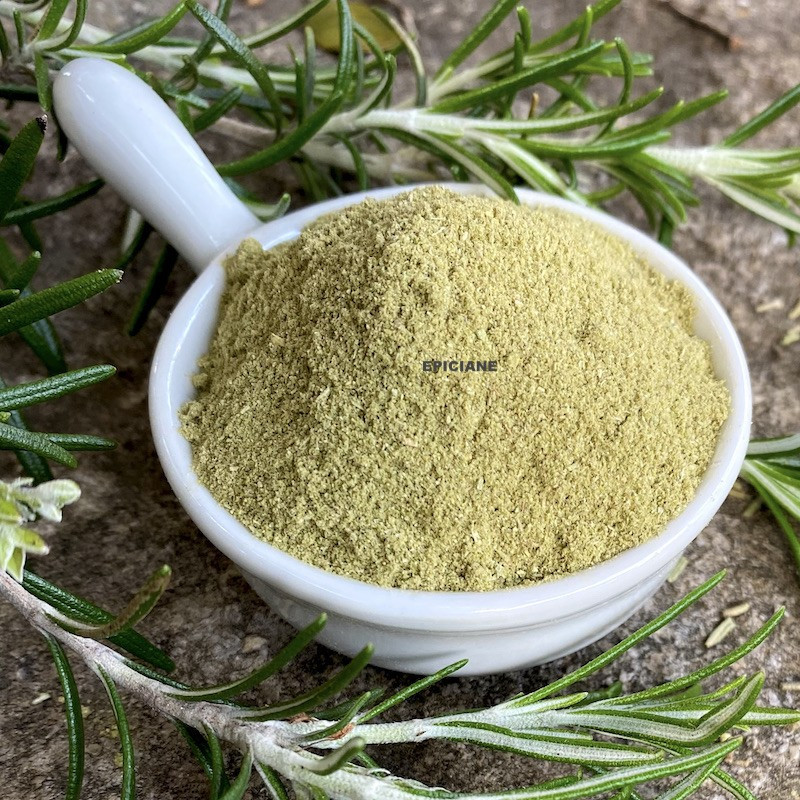
Reference: 021122


Rosemary is aromatic; it embodies the essence of Provence. Ground like this, it releases all its flavor without leaving any residue in the dish or on the palate!
Delicious on lamb and pork grills, in marinades and stews, it also contributes to the mix of herbs de Provence.
 Delivery
Delivery
Mondial Relay
 Returns
Returns
See conditions
 Payments
Payments
100% secure
Produit livré en sachet refermable
°°°
Uses in cooking:
Rosemary is one of the essential components of the mixture known as "herbs de Provence," and thus of Mediterranean cuisine.
Ground like this, it has the great advantage of not leaving any hard bits in the mouth, which can be bothersome for some. It will therefore impart all its fragrance without leaving any trace in the dish or sauce! It is commonly used in stews, casseroles, marinades, and generously sprinkled on grilled dishes. It pairs very well with potatoes and lamb. It can even be used to smoke meat or fish.
More recently, modern cuisine has featured it in infusions (whole leaves) to flavor custards, creams, ice creams, and even certain jams, especially apricot, fig, or peach. Less commonly, it is even paired with dark chocolate. In Provence, in traditional gastronomy, it is included in the preparation of citrus shortbread. And if you pair it with cinnamon, you will be delighted! All these uses are possible with infused leaves, but they will be even better with ground rosemary!
For whole leaves, their high concentration of flavonoids and phenols also makes them useful in infusions for their medicinal properties. Indeed, rosemary alleviates fatigue, digestive and liver disorders, respiratory infections, and headaches. In autumn and even spring, it is advisable to undergo a 2 or 3-week course of infusions at a rate of one teaspoon of leaves per cup, infused for 10 minutes. You can add thyme to the infusion and sweeten it with honey if you wish. A "miracle" remedy to start the winter off right!
Who am I?
Origin: Tunisia
Botanical name: Rosmarinus officinalis
Common names: Incense (Provençal name), crown herb, sailor's rose, sea rose, sea rosemary
Rosemary is a perennial shrub of the Lamiaceae family, native to the rocky maquis of the Mediterranean basin and growing almost everywhere with a temperate climate featuring mild winters and calcareous soil. It thrives in full sun and does not tolerate excess moisture. Its ability to thrive on the little humidity found along the coast may have inspired its name "rose of the sea."
It can reach a height of 1.5 meters, and its fine, leathery, needle-like leaves are evergreen. Their scent is powerful and camphorous, reminiscent of incense, hence the Provençal name "incensier." Its flowers are particularly honey-bearing, and bees produce a honey that is highly appreciated by connoisseurs, once known as "Narbonne honey."
Blooming begins in February and continues until May. Occasionally, a second, less abundant bloom appears in the autumn. The flowers appear in clusters that range from pale blue to violet, depending on the species. Some rarer varieties have white flowers.
There are over 150 varieties of rosemary that differ in size, shape, flower color, and hardiness.
It is also widely used as an aromatic component in the cosmetics industry to fragrance soaps, creams, etc., as well as in the food industry to flavor candies, sauces, desserts, etc.
Finally, its use in perfumery is very ancient. One of the earliest known alcoholic perfumes is "Hungarian water," of which it is the base, frequently used in the 17th century. It is still used today in the production of perfumes, primarily for men.
A little history:
The ancients held it in great reverence. It was used in all festivities. Brides wore crowns made from it (hence its nickname "crown herb"), and guests were given branches adorned with multicolored silk ribbons.
Its stimulating effect on mental functions led the ancient Greeks to crown students with it. Sprigs were also placed under pillows to chase away evil spirits and nightmares. The ancient Egyptians placed rosemary branches in the tombs of pharaohs to strengthen their souls.
As for the students of ancient Greece, they made crowns from it to wear during exams, believing it would enhance their memory.
During plague epidemics, due to its antiseptic properties, branches were burned to purify the air, and small sachets were worn around the neck to be inhaled when passing through areas contaminated by the disease.
Finally, a legend says that originally, rosemary had white flowers. Mary, before giving birth to Jesus, would have laid her blue cloak on a shrub before entering the stable. This shrub was a rosemary plant. The color of Mary's cloak is said to have bled onto the flowers of the shrub, which is why, since then, rosemary blooms blue!
Data sheet
Reference: 021122
Reference: 050721
Reference: 508212501
Reference: ecorceorangeamere
Reference: 3N7201902
Reference: 20703402
Reference: 00033663-0001
Reference: 10707402
Reference: coriandreE
Reference: 11N78924G1
Reference: 9N7655101
Reference: jasmin
Reference: paindepices
Reference: 30811001
Reference: 10814501
Reference: 20731803
Reference: 408164502
Reference: L0012691123

Rosemary is aromatic; it embodies the essence of Provence. Ground like this, it releases all its flavor without leaving any residue in the dish or on the palate!
Delicious on lamb and pork grills, in marinades and stews, it also contributes to the mix of herbs de Provence.